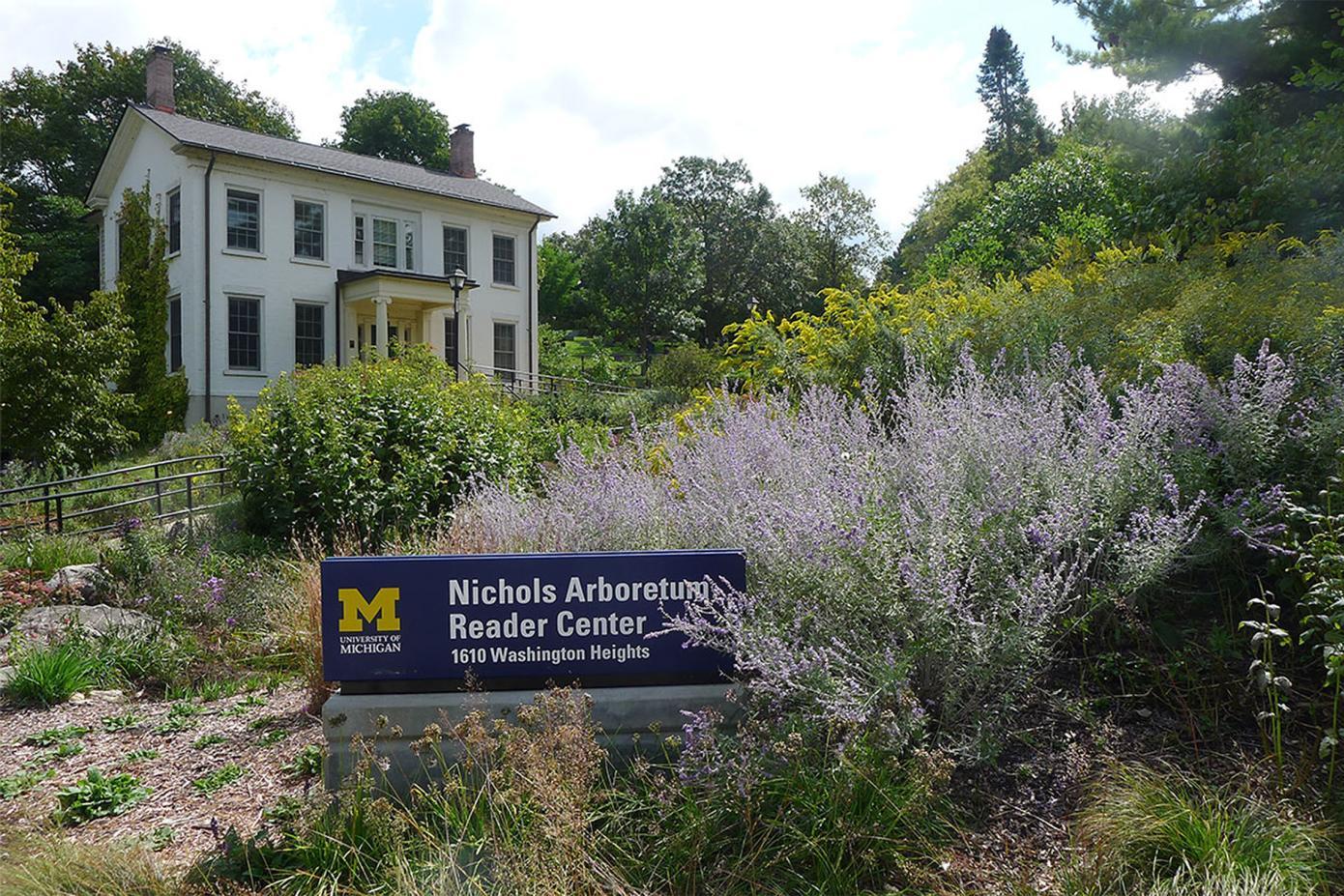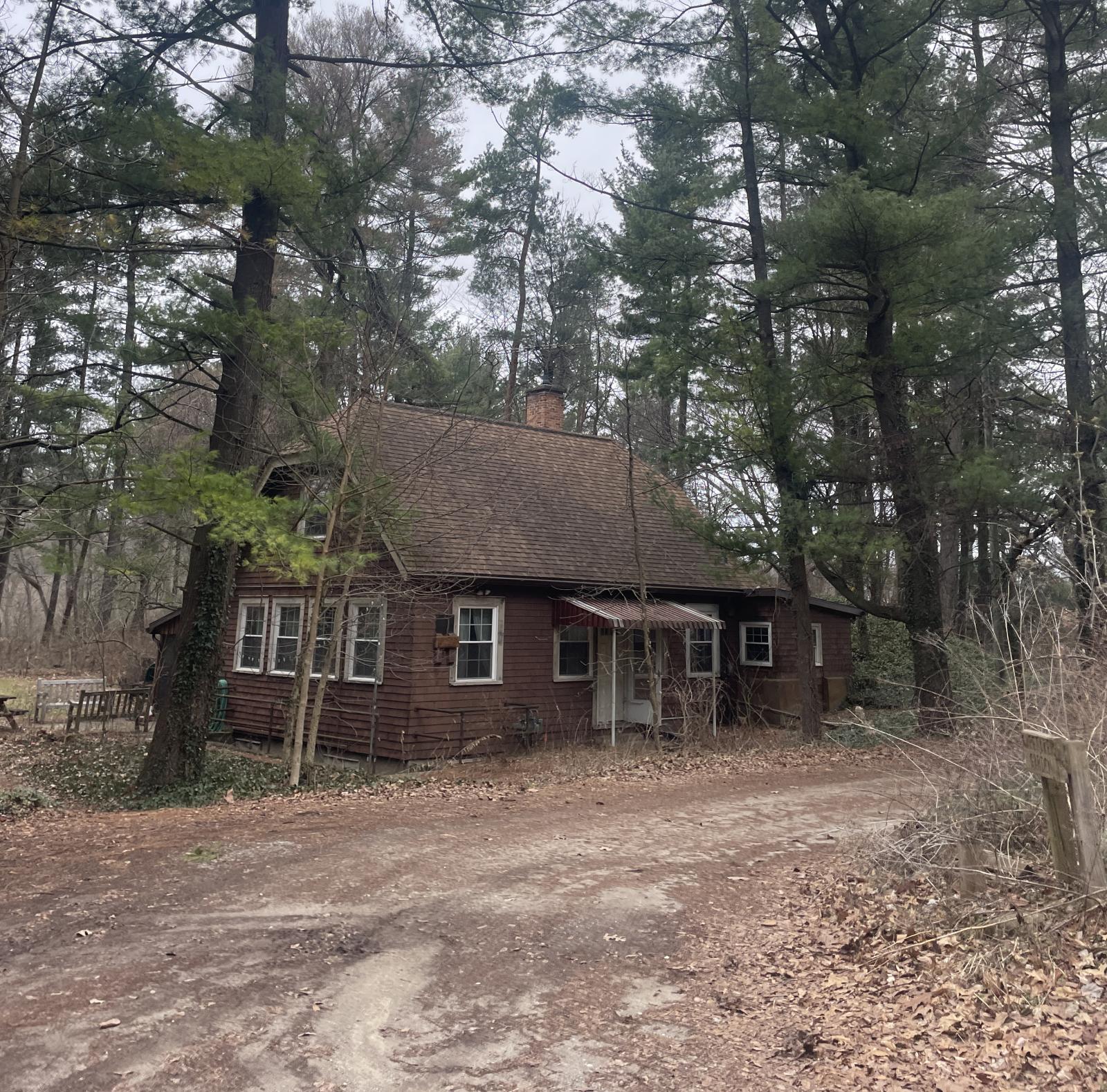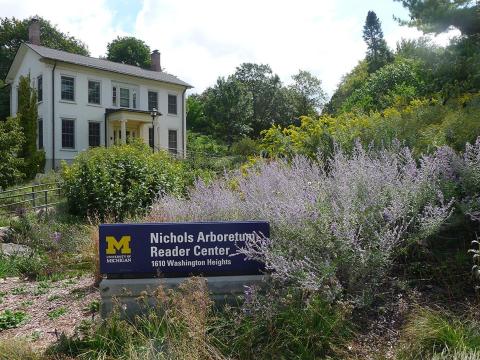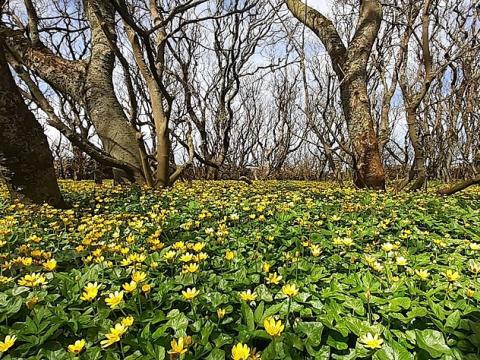
Would you live in the Arb? A tree-filled oasis nestled in the city, Nichols Arboretum isn't just home to foxes, squirrels, and birds—it's also home to a dedicated group of Arb caretakers. While the role has grown and changed since its inception in 1991, it continues to allow students to engage in active land stewardship while living at the Arb. Currently, five stewards live on-site: Tegwyn, Sara, Mary, Jenna, and Emma.
The caretaker deal? Work ten hours a week in exchange for housing in one of two Arb residences. Caretakers are responsible for environmental restoration, facilitating eco workdays, MBGNAʻs weekend volunteer habitat restoration events, and the dirty job of “rounds,” a nice term for emptying the trash cans throughout the property. In addition, the caretakers provide a constant presence at the Arboretum. As Tegwyn says, “Part of the job is being the eyes and ears of the Arb.”

Two caretakers live in the upstairs apartment of the Reader Center, a historic house at the Washington Heights Entrance of the Arb, above the visitor center. The other three live deep in the Arboretum, at a home lovingly named the caretaker cabin. Built in 1914, it sits on a glacial kame overlooking the main valley. It was once the home of the former Arboretum superintendent and had a greenhouse attached at the time of construction. Despite its age, its wood-paneled walls haven’t lost their charm, although the cabin has increased in its number of mouse residents. Emma had noted that visitors often say it feels removed from the rest of the city, like an up north cottage nestled in some wilder place.
The job has its perks. Few can claim the peony garden as their front yard, drive their car through the Arboretum, or step outside to drink their morning coffee perched on a black oak log in Hawthorne Valley. However, the caretakers cite their favorite part of the job as the meaning they find in their work, especially at eco workdays. These workdays offer a time for collective work on a common goal, and Mary is fond of the easy talk that flows when working alongside others. “I’ve had some incredibly amazing conversations with people - their ethos, their passions, big life events happening for them….I think getting a big group of people together working towards a common goal tends to bring things out like that. Tegwyn describes how these volunteer events go deeper than invasive species removal. “I love introducing people to the world around them in practical ways while adding meaning and relationality to that. Not just talking about the plants we are working with, but how they relate to the rest of the ecosystem or humans, presently or historically, and helping people get curious and excited about the living world around us.”

The caretaker’s hard work changes the Arb’s ecosystems for the better, and in turn, it seems the land does the same to them. A quote painted on the burr oak leaf bordered walls of the Reader Center sums it up nicely: “Happiness comes in largest measure to those who live in closest harmony with nature.” Living at the Arb offers front-row seats to the seasons changing and to the patterns that play out over the course of a year. “Every day, just leaving the house, immediately I'm in nature,” Sara shares. All of the caretakers agree that even with the pressure of school and work, living in such close proximity to nature invites an attentive presence and pace. What does this mean for Mary? “My internal calendar runs on Arb time.”
The job has its share of challenges, too: raccoons wreak havoc in the trash cans, rowdy youth come to gather after hours, and visitors sometimes need reminding about the policies around bikes, hammocks, and dogs off-leash. But even in some of these more challenging moments, caretaker Jenna finds opportunities for education. “Normally, when I'm approaching people who have their dogs off-leash, I'm trying to teach them that there are animals hibernating, there are plant species that are coming up that are juvenile, and treading on them would be harmful. It's not just about rules. I think the education portion of it is so special.”
A quieter challenge is that caretaking means living where you work and feeling a constant responsibility to the land. For Sara, even a walk through the Arb comes with an increased awareness of the work not yet done. “My whole walk home, I see things I should and could do. I am mentally cataloging a lot of the time.” Jenna echoes this challenge in her efforts to support stormwater management in the Arb. “This Arboretum is working really, really hard for the city of Ann Arbor, and I do wish that there was more acknowledgement of that on the city level. The topography and the trees are just really laboring to make sure we don't have flooding and cleaning water before it goes to the Huron River. I didn't expect to feel so responsible. Because we have a small crew, there are so many things that you could do, and you have to choose some of the things you want to do, and know that everything helps.”
As caretakers, they all hold rich stories of the Arboretum, stories of interactions with visitors, wildlife encounters, and watching the Arb change over time. Sara has a story of a bird encounter at an eco workday. As volunteers worked to dislodge a tree that had fallen onto another, they spotted a large bird balanced on its trunk. “We had twenty people gathered around, using chainsaws, and he was just hanging out. When the tree finally moved a little bit, a mouse ran out. Then, we all watched the hawk swoop in, grab that mouse, and fly off with it. I was like, “You're a smart bird. You know exactly what you're doing.”
Jenna was lucky enough to spot a beaver along the Huron. “We had had a big storm, and so I wanted to see how big the river was getting, and I saw it pop out of the storm drain. I was trying to get every last glimpse of it before it disappeared. And that was pretty special. It made me realize that my desire to be curious about things in this place would reveal a lot, and if I followed those curiosities, I probably would be rewarded.”
The Arb was the first place Mary visited when accepted to Michigan before she ever set foot on campus.“ I think about that a lot now. I’m grateful that the Arb has become such a big part of my life. It feels very full circle.
Some memories are heavier than others. Tegwyn recalls the night of the August storm in 2023 that downed over 100 trees near the peony gardens. As the eyes of the Arb, they were the first to report the loss to the broader organization. “It was so dark, and there was a massive oak tree down right behind the information kiosk at the Washington Heights entrance that totally blocked the way into the peony garden. I turned my flashlight on and climbed through. And it was total devastation. In some instances, it took out a century's worth of tree growth. I didn't know at the time just how many trees we lost. Still, I remember the feeling of encountering that aftermath, and how it felt it was both surprising, and on the other hand, I've been studying climate change for so many years that I also felt like I knew it was coming. I grew up going to the Peony Garden, and we lost a lot of trees that I've known my whole life—that so many people knew their whole lives—and that hits differently than all of the graphs. To have experienced that much loss and that much transformation of space and to notice how easily it's normalized and how quickly it's forgotten has been striking.”
Originally from England, Jenna likens the Arbʻs diversity of habitats to her home. “The Arb is like a city where you have these defined personalities in different pockets. It's almost like the City of London, where there are boroughs. Here you have the borough of School Girls Glen, the borough of The River, and the borough of the Dow Prairie. And it works like a city together. The wetland moves into the river, and the hills take the water down to the river.” This metaphor extends to something she grapples with in this role: anticipating loss by climate change or destructive “black swan” events like the 2023 summer storm. “When you think about one of the boroughs being damaged, it throws off the equilibrium. When I hear people talk about [that storm], it wasn't just the workload, but also the worry that maybe this was normal from now on.”
If youʻre heading to the Arb soon, check out a few of the caretaker’s favorite boroughs. Tegwyn and Sara are fond of the East Oak Woods, overlooking Dow Praire. As Tegwyn explains, “Those are our highest quality ecosystems, which means we get many interesting native plants and lovely views from the hills.” Sara says she finds new trails every time she goes there. “ It feels like you're really in the forest. You're in the wild.” Jenna gravitates to the river: “It's such a lifeline, and it's why the city's here. Sometimes it looks like gun metal, and sometimes it looks almost like aluminum blue, and then sometimes it looks inky. It's just all about light; light and water are such friends. It's really a painting.” If youʻre in the Arb on a warm day, Mary recommends lying in the white cedar grove: “It smells amazing.” One of Emma’s favorite spots is right outside their door. “There's a thin trail running up the kame the cabin sits on, to the tip of it and then down. It's overlooking everything. And I feel like I'm like a hawk getting a bird’s eye view, really taking the eyes and ears to heart.”
Despite its 30-year legacy, the caretaker program is widely unknown to Arb visitors. People walk past the caretake cottage without blinking an eye while others turn around, thinking they’ve left the Arboretum and wandered onto private property. As Emma shares, “A lot of people don't even know that we exist, but I think it's cool for people to know that we are here to serve the land and care for it. I feel like we can be a bridge between nature, the Arb, and the public.”
Next time you see a car driving through the Arb that seems out of place? Don't worry; that’s likely just a caretaker coming home.


